|
1.
CENTRAL/ WEST AFRICA
Ban appears certain
Trade analysts now believe the log export ban in Gabon
appears certain to come into effect as from 1st January
2010. This view has been formed on the basis of reports
on various trade meetings with senior government officials
rather than from official announcements.
No details have been issued by the government of Gabon
and as a consequence the timber industry remains
pondering what business plans and sales strategies it
should implement. Importers in the consumer countries are
in a similar situation and will have to adapt very quickly to
a changed trade flow where a large volume of logs will no
be longer available.
Ban to change trade flows
This change in trade flow will affect materials handling
businesses at the ports and will drastically impact
shipping, in particular existing time charters.
The trade is saying that, currently, there is insufficient
capacity in Gabon to process the total allowable log
harvest and that this will mean logging capacity will be
underutilized and that there will be some loss of
employment in the logging sector.
Alternative investments
Trade sources in Gabon believe that the government
strategy is to seek expanded investment in non-timber
sectors of the economy such as mining and agriculture and
that it expects this expansion will absorb the workforce
that will be displaced from the logging sector.
It is also rumoured that Gabon may be planning to access
very substantial financial benefits in carbon capture
payments through the REDD scheme that will help to fund
the new policy to develop the industries outside the timber
sector.
As to market reaction, the period November through to the
end of January is, in normal economic times, the quietest
for much of the global timber trade.
No price impact - yet
While there has yet to be any discernable general change
overall in price regime, both producer and consumer
markets are certain to be reviewing their options in the
light of the probable Gabon log ban. Until the producers in
Gabon have had time to assess how to deal with the new
situation it will not be clear of what the effects may be.
The currently operating processing mills in Gabon could
not immediately absorb a major input of large quantities of
logs so there will not be a sudden surge in output of
sawnwood or further processed products. It would take
time before new mills, or those mills under construction
could be brought into full production.
The trade is convinced that the major market impact in the
first quarter of 2010 will be the removal of Gabon¡¯s log
exports from the global market.
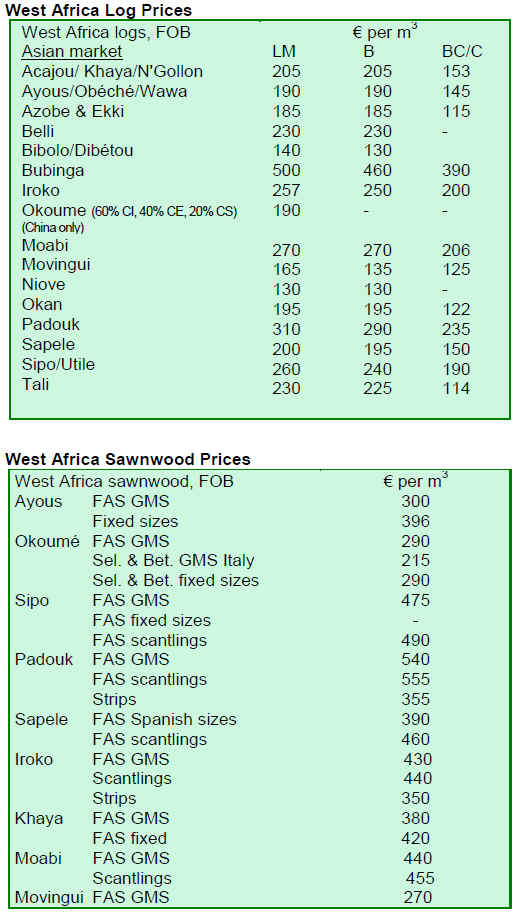
2. GHANA
Third quarter market status
Prices for wood products improved slightly during the
third quarter of 2009 as compared to the first and second
quarters. Timber industry sources attributed the slight
improvement to the ending of the recession in the major
importing countries notably Germany, France, United
Kingdom and the USA.
Dahoma selling well
There has been a significant improvement in prices of
Dahoma sawnwood especially to the Middle East markets.
Dahoma sawnwood prices improved from the previous
quarter levels of between US$290 per cu.m and US$310
per cu.m to an average price of US$350 per cu.m during
the quarter under review.
With the recent high demand for this timber it is
anticipated that prices could rise further in the subsequent
quarter.
Generally, there were improvements in prices of between
EU5 and EU10 for sawnwood. During the quarter, most
sawnwood contracts for high density species especially
Danta and Denya found their way on the Chinese market.
Though prices offered by the Chinese buyers were
between $20 per cu.m and $40 per cu.m below the Ghana
Guiding Selling Prices (GSP), it was a significant
development for the Ghana timber industry since these
species are not sought after by buyers in the traditional
markets of Europe.
Rosewood enquiries
During the quarter under review a lot of inquiries were
circulating for Rosewood, locally known as Kosso in the
Volta Region and Kraye in the Brong Ahafo and Ashanti
Regions.
Few contracts were approved for this species to the Indian
and Chinese markets with prices ranging between $430
per cu.m and $450 per cu.m. On the premise of the high
number of inquiries for Rosewood, it is anticipated that
more contracts for this timber could be secured in the near
future.
Ghana export Performance
A total of 2,847 export permits were vetted, processed,
approved and issued to exporters during the third quarter
of the year 2009. These covered shipment of various wood
products through the ports of Takoradi and Tema as well
as overland exports to neighbouring ECOWAS countries.
The corresponding figure of total export permits issued for
the previous quarter was 1,654, thus in the third quarter
there was a substantial increase (72%) in the number of
permits issued.
This was attributably partly to the greater number of
permits issued for the export of Teak billets, poles and
logs. The increased export permits during the quarter, was
also a reflection of the fact that overland exports to
neighbouring ECOWAS countries have been increasing
despite the global credit crunch.
Air- and kiln-dried sawnwood shipments continue to
account for the highest number of export permit
applications. The demand for sawnwood was higher than
for secondary processed wood products like furniture
parts, mouldings, floorings, dowels etc.
For the third quarter of 2009, there was a substantial fall in
the number of permits issued for the export of boules.
Nonetheless, the number of permits issued for the export
of sawnwood, rotary veneer, sliced veneer, plywood,
mouldings, layons and Teak billets/poles/logs rose during
the period.
This increase, say analysts, is mainly attributed to the
increase in demand for sawnwood and rotary veneer in the
US market.
The increase is also attributed to increased demand for
sawnwood, rotary veneer, sliced veneer, mouldings and
layons in the EU market as well as increased purchases of
sawnwood and plywood in the ECOWAS market,
particularly Nigeria.
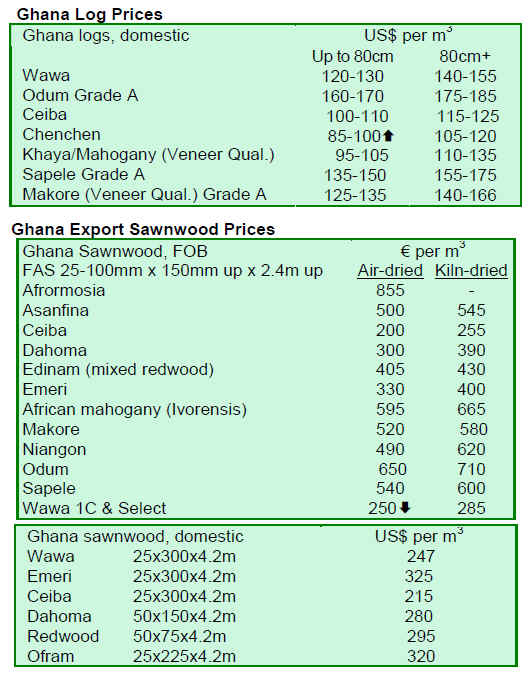
3.
MALAYSIA
Malaysia¡¯s export of timber and timber products declined
by 18% to RM13.95 billion in the first 3 quarters of 2009,
in comparison with the same period in 2008,. The decline
affected the sawnwood, plywood and wooden furniture
sectors.
This was revealed by the Malaysian Timber Industry
Board (MTIB) at the Industrialised Building System (IBS)
seminar held in Kuala Lumpur recently.
Lamtec, a locally registered trade mark for Malaysian
wooden laminated scantlings has found wide-acceptance
in the German market largely because of the efforts of a
German company PADO Elementebau GmbH, a window
frame maker. The German manufacturer is using
Malaysian and local timbers.
Lamtec¡¯s is the result of collaboration between the
Malaysian Wood Industries Association (MWIA), Forest
Research Institute of Malaysia (FRIM), Malaysian Timber
Industry Board (MTIB) and Malaysian Timber Council
(MTC).
Lamtec is also reportedly making its mark in the Austrian
as well as the US markets. The Malaysian timbers used in
the manufacture are Meranti, Kasai, Bintangor and Gerutu.
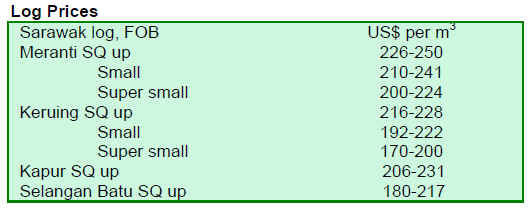
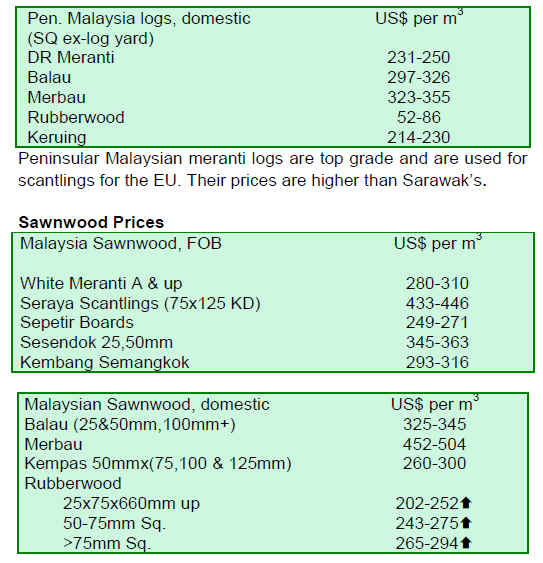
4.
INDONESIA
After three years of negotiation with the European Union
(EU), Indonesia is apparently still reluctant to sign a
voluntary accord aimed at stopping illegally harvested
timber and timber products from entering the EU market.
Indonesia's chief delegate to the negotiation is reported as
saying that Indonesia will continue to focus on enforcing
good governance in forests management before signing the
Voluntary Partnership Agreement (VPA). The Indonesian
authorities have decided to wait until they can assess the
impact of the EU-Ghana VPA.
Indonesia had previously signalled its intention to sign the
VPA which would ensure that all timber and timber
products entering the EU market derived from legitimate
sources. Indonesia exports up to third of its timber and
timber products to the EU annually.
The EU is also finalising a new regulation, expected to be
adopted in 2010, which will require timber traders in the
EU to implement procedures to mitigate the risk of illegal
timber being traded in the EU.
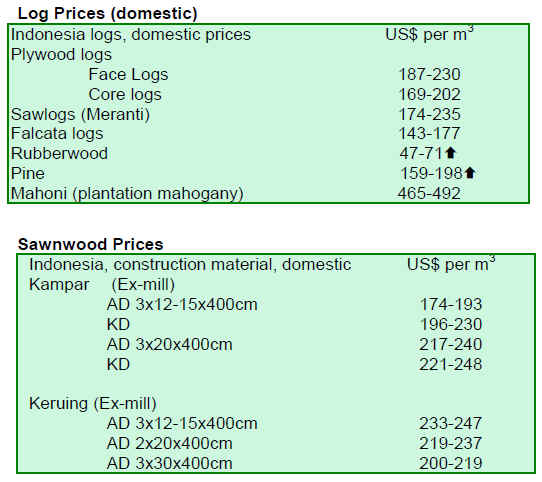
5.
MYANMAR
Trade cautions on volumes for tender
Market conditions remain unchanged from the time of the
previous report. 2009 has been an important year for
Myanmar teak.
The recession in the West has had a disturbing influence
on the teak trade. The huge domestic market for teak in
India remains strong mainly because teak is indigenous to
India and therefore has a special place in the minds of
consumers. Other markets that purchase teak, mainly for
re-export have shown signs of weakening over the past
few years.
2009 has not been a good year for the timber traders in
Myanmar and all are looking for the market to pick up
during the middle of 2010.
A report by one experienced timber trader on the
November teak tender is quoted below:
¡¡ãBecause of short supply, the prices for fair and good
decent parcels are still holding to the normal market
prices. Other poor and average quality parcels are below
the normal range of prices.
Anyway, in general, the prices for this month are slightly
better than last month, because of the very small quantity
put on sale. The seller (MTE) should be careful that if too
small quantities are put up for sale, the general interest in
Teak might fade away. It is important to supply the market
with a reasonable quantity, to keep commercial interests.¡¡À
The above comment relates to the very small quantity of
teak logs put up for sale in the recent months compared to
the 5000+ton monthly offers in the past many years.
Sellers versus buyers¡¯ market
Some analysts even went on to comment that teak has lost
ground and the market is now a Buyers¡¯ market. Price
fixing; controlled delivery schedules and counter-offers on
specifications used to be the prerogative of the sellers in
the years prior to 2000.
Now, sellers no longer enjoy these privileges and have to
yield to buyers¡¯ demands.
Analysts said this reference relates to natural forest teak
only, as they consider ¡®plantation teak¡¯ as a commodity
only like any other timber.
The same trade analyst expressed the hope that Myanmar
would gradually scale down the harvesting of teak, for
economic reasons and also for preserving a timber which
is considered a national heritage.
Further, he suggested that Myanmar should do some
serious restocking in the natural forests. Some opined that,
more serious and responsible checks should be in place to
protect this special timber from irresponsible harvesting.
Conservationists view with concern the growing shipment
of large quantities of teak logs of smaller dimensions and
poorer grades.
What now for Myanmar teak?
There are rumours circulating that the MTE monopoly on
timber (including teak) extraction may be withdrawn.
When more information on this emerges it will be
reported.
The history of teak extraction by State agencies goes back
a long way. The State Timber Board (STB) ¡§C the precursor
to the now Myanmar Timber Enterprise (MTE) - was
formed under the State Timber Board Order 1948 and the
State Timber Board Act of 1950.
STB handled all teak extraction from that period on.
Milling of teak was done by the State sawmills. Private
sawmills were also allowed to purchase teak logs in the
STB auctions; mill them and sell in on the domestic
market. They were also permitted to export.
In 1964, all remaining non-teak hardwood activities were
nationalised and operated solely by the state. By the
1990¡¯s MTE has started relinquishing its monopoly on
teak exports and also on the extraction of non-teak
hardwoods.
Teak plantations were permitted for private entrepreneurs
in 2004. By 2009, a major portion of MTE¡¯s timber
extraction was being done by private companies. The first
decade of the 21st century is witnessing significant
changes in the Myanmar forestry sector. In the words of
the ITTO correspondent in Myanmar ¡®Whither goest
Myanmar teak?¡¯ 2010 may provide an answer.
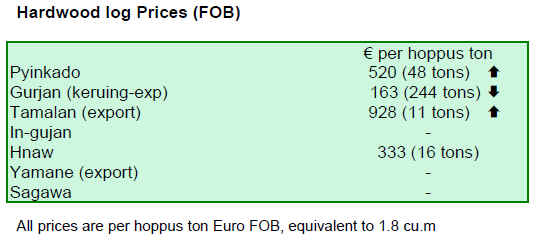
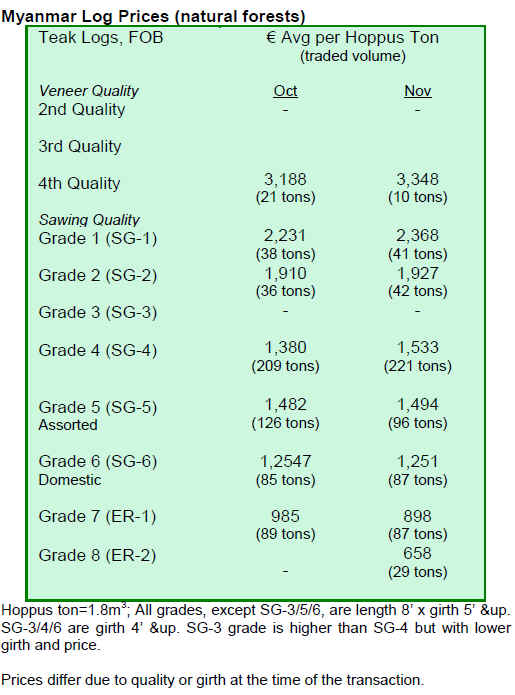
6. INDIA
GDP continues upwards
India¡¯s GDP for the third quarter 2009 at 7.9% beats
market expectations and defies all forecasts. A strong
upward rise from last month¡¯s 6.3 % is a welcome rebound
for the manufacturing sector and better than expected
news for the large agricultural sector. The timber trade
remains buoyant with consumers showing more
confidence to spend.
The growth forecast for the current year may be raised
from 6.5 to 7.0 %. The Indian Planning Commission feels
that the economy is back on its normal growth path.
Global Warming
On the issue of carbon dioxide mitigation there is some
encouraging news from India. The latest government
reports show that the forest cover is steadily increasing. In
the last ten years India¡¯s net addition to its forest cover has
broadly been 300,000 hectares per year and the country¡¯s
total forest and tree cover is 78.4 million hectares or
around 24% of its geographical area.
The ¡®India State of Forest Report 2009¡¯ reported that
India¡¯s forests absorb some 11% of the country¡¯s
greenhouse gas emissions. Improving the forest cover is a
centerpiece of Indian strategy to combat climate change
according to the Indian Environment and Forest Minister
Mr. Jairam Ramesh when launching the report.
Broadly about 34 per cent of the country¡¯s forests fall in
the tropical moist deciduous category, 30 per cent in the
tropical dry deciduous, 11 percent in Himalayan
temperate, 9 percent in the tropical wet evergreen
category, 6 per cent in sub-tropical pine and 5 per cent in
the tropical thorn category, says the report.
There is general consensus amongst industry that it is
necessary to cut greenhouse gas emissions.
Teaknet
Teaknet (International Teak Information Network
http://www.teaknet.org/) recently held an international
workshop on Production and Marketing of Teak with
support from FAO, the Asia Pacific Association of
Forestry Research Institutions, Kerala Forest Research
Institute and the Indian Ministry of Environment and
Forests.
Papers were presented on ¡®Transforming the Teak sector¡¯;
Teak Forest Certification, Prospects and Problems of Teak
in Bangladesh and Organizing markets for Teakwood
under a commodity futures system.
Issues in the international trading of teakwood were
discussed by Mr.R.T.Somaiya of the Timber Importers
Association of India, Global trends in production of
Teakwood plus several interesting papers on the
silvicultural aspects and disease control in teak plantations
were presented. A final report will be produced by the
Teaknet co-coordinator Dr.K.Jayaraman.
Teaknet not only focuses on the Asia pacific region but is
now truly international with members from 38 countries
around the world which are growing teak.
Three new members were added to the steering
committee; Mr.Ramon Carrillo, ITTO; Mr.Walter Kollert,
FAO and Mr. Lars Graudal from Denmark who was also
elected as the new Chairman of the Teaknet Steering
Committee.
The current market price for Teak logs at the Indian
auction is as follows:
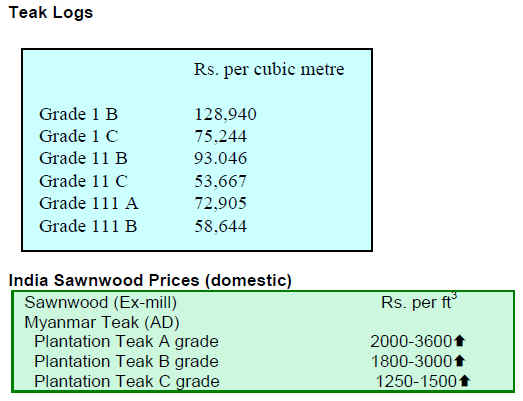
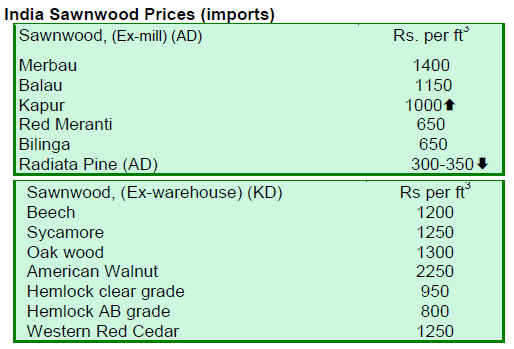
7. BRAZIL
Logs from managed forest
Forest management practices are well established in state
of Mato Grosso and beginning in the 1990s timber
industries realised the need for conservation and
sustainability.
Now, the industry associations want to show that forest
harvesting has changed and that the focus is on sustainable
harvesting management taking only those trees suitable for
processing into lumber, plywood, furniture and other
products.
According to the Northern Mato Grosso Wood Industry
Union (SINDUSMAD) over 90% of the logs for timber
products manufactured in the state come from managed
forest.
In the Amazon, only 20% of the area of a forested
property can be cleared, the remaining 80% must be
sustainably managed by law.
In Sinop, the Sindusmad, Cipem CIPEM (¡®Centro das
Ind¨²strias Produtoras e Exportadoras de Madeira do
Estado de Mato Grosso¡¯) and Famad (¡®Fundo de Apoio ¨¤
Madeira de Mato Grosso¡¯) released a movie documentary
showing the new reality of the logging activity in order to
change the image of the regional timber industry.
Tax break for furniture
The government's decision to extend the exemption of IPI
(Tax on Industrialized Products) for the furniture industry
should generate a 6% increase in sales in December,
according to a forecast of ACSP (São Paulo Commercial
Association). Wooden furniture currently attracts a 5% IPI
but this will become zero until March 31 2010.
An optimistic view was also expressed by the Brazilian
Furniture Manufacturers Association Abim¨®vel which
believes that sales could grow 15% in the first quarter of
2010.
However, the sector was showing a sign of recovery even
before the tax exemption measure was announced. The
ready availability of credit has contributed to stabilise
sales. Analysts point out that the tax exemption measure
took too long to be defined but, never-the-less, it should
bring many benefits to the furniture sector.
The furniture manufacturing sector has had a difficult time
because most sales are export-oriented and exports have
fallen as result of the economic crisis.
Furniture raw materials cheaper
The Brazilian furniture industry has a great potential for
export. Last year, exports were over US$980 million but
for 2009 the strength of the real against the dollar has
become an obstacle to expanding exports. However, the
strong Real means that imported raw materials for the
furniture sector have become cheaper such that it is now
feasible to buy raw materials at a competitive cost, to
process and add value and then export the finished
product. In
As pointed out by some manufacturers, the margin saved
on raw materials partially compensates for lower export
sales, the result of the unfavorable exchange.
This is especially true for the solid wood and high-end
furniture industry when importing hardwoods and veneer
from the United States.
Out of the total volume of 7.2 million cu.m of sawnwood
and wood panels consumed in 2008 by the furniture
industry in Brazil, solid hardwood and pine accounted for
2.3 million cu.m and 1.8 million cu.m respectively. But, of
this, only 1% of the solid hardwood and 2.9% of the solid
pine was imported. The level of raw material imports by
Brazilian manufacturers is likely to grow if the Real
retains its strength.
Para timber sector recovery
According to the Association of Timber Exporters of Par¨¢
State (AIMEX) the recovery of the timber export sector in
the Northern Amazonian state of Par¨¢ in the second half of
the year helped lower the unemployment rate.
Recent employment statistics show that, after eight
consecutive months of deficit, in September the state¡¯s
timber sector reported the creation of over 800 new jobs
and the trade is saying this trend is likely to continue for
some time.
Between August and October this year, Par¨¢ exported 54%
more than in the first half of the year. This translates to a
trade value of only US$175 million between January to
July 2009, only half of the value of exports in the months
of August to October (US$ 375 million).
The export recovery is the result of the improved
economic situation in the main markets of the US and EU.

8.
PERU
Forest Convention
The 5th National Forest Convention, organized by ADEX
(Peru¡¯s exporters association), focused on the latest trends
in World markets and opportunities in Asia.
During the opening, the president of the exporters
association, Jose Luis Silva, indicated that Peru has the
possibility of becoming an important exporter of wood
products.
He said that members of the association are concerned
that, while Peru has more than 70 million hectares of
forest, it is still a net importer of wood products. This was
put down to the lack of effective policy for the
development of the timber sector.
Hard hand on deforestation
Peru¡¯s exporters association (ADEX) has called for firm
action by government to address deforestation in the
Peruvian Amazon which is reported as around 150,000 ha.
annually. This said the association could be addressed
through incentives for activities other than agriculture and
ranching, two of the main causes of deforestation in the
country.
Forest clearing by charcoal producers was also identified
as a cause of deforestation and ADEX, while recognizing
the need for the government to support income generation
through charcoal production; such production should be
managed in a sustainable manner.
Protect a tree
The UK based Cool Earth has apparently started a
campaign to get sponsors in Britain to fund a programme
to help protect the tropical forests in the Ashaninka region
of the Peruvian Amazon. Sponsors are asked to contribute
£1.00 per tree, the amount said to be required to protect
trees from illegal logging. Cool Earth is looking for
100,000 sponsors to raise the necessary £100,000 it deems
necessary to protect the designated area of forest.
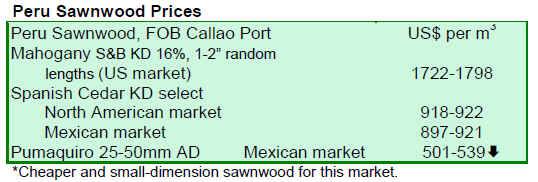

9. BOLIVIA
Small enterprises dominate
Exports of forest products in the third quarter 2009 fell
14% compared to 2008. Despite the poor export
performance the share of forest products in total exports
maintained a 6.5% share in trade.
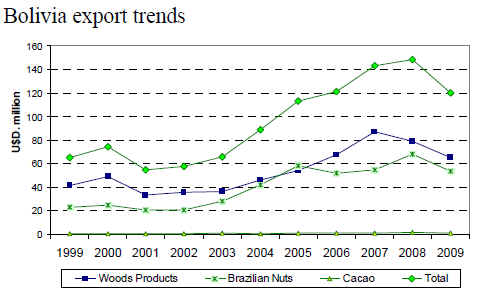

10. MEXICO
Market dependence
Mexico¡¯s main trading partner by a considerable margin is
the US and some 85% of the country¡¯s exports are
dependent on markets in N. America. Because of this
dependence, Mexico¡¯s external trade has suffered this year
because of the weak demand from its northern neighbour.
Despite the economic downturn in the US 2008 furniture
and household goods exports held up well.
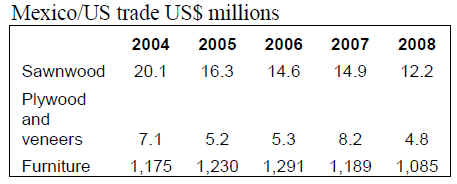
Interest rates held
Mexico's central bank has decided to hold interest rates at
4.5% a rate that has been in force for the past four months.
For most of the year interest rates have been progressively
cut in an attempt to spur growth.
Good news and bad
In the third quarter 2009 the Mexican economy grew by a
reported 2.9% but, for the year as a whole it is estimated
that GDP will fall by between 6-7%. On the positive side
inflation at around 4%, just 1% more than the goal set by
the Central Bank, is expected to fall in 2010.
World Bank support
In other news the World Bank recently approved a $1.5bn
loan to Mexico in support of the Mexican government¡¯s
economic stimulus measures.
Analysts expect most of the effort to be put into
stimulating employment and into financial regulatory
reform.
CONAFOR News
News from CONAFOR can now be found in under
Internet News on page 18.
11.
Guyana
Log market firm
During the second half of November the volume of logs
exported declined but there was an increase in production
and trade of finished and value added products.
Export prices for Greenheart logs remain unchanged while
prices for Purpleheart (standard sawmill quality) recorded
a very positive rise in average prices (USD 330/235). On
the other hand, there were price falls recorded for
Purpleheart Fair and Small sawmill qualities. There were
no Mora logs exported at the end of November.
In comparison with the previous two weeks the latest
prices for sawnwood achieved a higher average price; this
was especially noticeable for Greenheart (Prime and
select). In sharp contrast Greenheart merchantable grade
sawnwood prices eased.
Sawnwood, mixed fortunes
Purpleheart sawnwood (select and merchantable) achieved
good average prices but Mora (select) sawnwood prices
recorded a drop in average prices. However merchantable
grade Mora was selling well.
Producers of Dressed Greenheart are currently enjoying
high prices, as are producers of Dressed Purpleheart which
is selling at US$ 900/1126.
Baromalli plywood
As regards plywood, both BB/CC and Utility grade
Baromalli were exported but BB/CC grade ply
experienced a drop in price compared to levels two weeks
ago.
Roundwood exports contributed to foreign exchange
earnings and achieved good average prices for the period
under review. Splitwood also contributed to the export
earnings during the period.
Value added product exports during this period included
doors, indoor furniture, mouldings, builders joinery,
windows, wooden utensils and ornaments exports of
which contribute significantly to the overall export
earnings.
Agency cooperation
As the Norway forestry support for Guyana begins,
Guyana is taking steps to increase oversight of mining
operations and the impact on forests by increasing the
number of Mines officers stationed across the country.
The mining community is being challenged to be more
transparent and identify procedures and practices to
minimise irreversible damage to the forest.
For many years the mining and timber sectors have
clashed over the extent of forest degradation in the course
of mining. A statement from the Office of the Prime
minister said ¡°The recent agreement with Norway, through
which Guyana receives payments to avoided deforestation
and degradation, now puts a significant monetary and
moral cost to any unnecessary degradation of forest areas
for any purpose¡±,
The mining sector contributes massively to Guyana¡¯s
export revenue earnings and provides work for thousands
but now needs to review its operational methods.
Plans are being drawn up to increase the coordination
between the Guyana Geology and Mines Commission and
the Guyana Forestry Commission.
The mining sector has come under increased focus
because of the forest damage caused and have been
advised that they would have to radically transform their
operations.
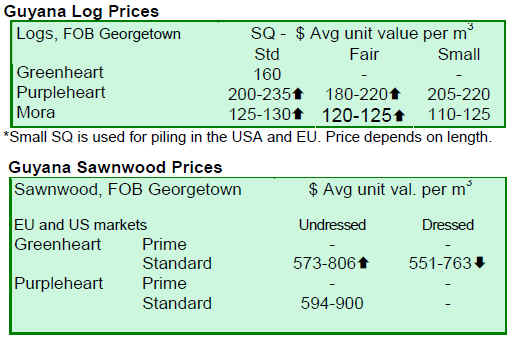
|